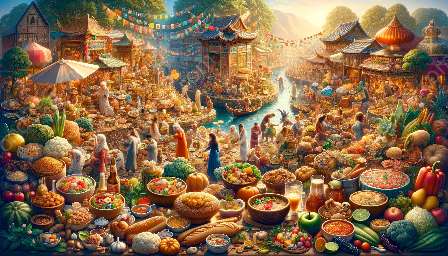Food packaging and storage techniques have evolved over centuries, reflecting the food traditions, culture, and history of various civilizations. Ancient practices such as fermentation, salting, and drying were integral to preserving food for sustenance and celebration.
Early Food Preservation Techniques
Ancient civilizations developed ingenious methods to extend the shelf life of food. Early food packaging and storage techniques were deeply rooted in necessity and practicality, often intertwined with rituals and traditions.
Fermentation and Pickling
Fermentation was a common method used by ancient cultures to preserve food. This process involved the transformation of sugars and carbohydrates in food into organic acids or alcohol, preventing spoilage. Vegetables, fruits, and even dairy products were often pickled to preserve them for consumption during lean times.
Drying and Dehydration
Drying food, such as fruits, meats, and fish, was another prevalent method of preservation. The removal of moisture inhibited the growth of bacteria and molds, allowing food to be stored for extended periods. This technique was particularly vital for nomadic and agricultural societies.
Salting and Curing
Salting and curing were traditional methods employed to preserve meat and fish. The use of salt drew out moisture from the food, creating an inhospitable environment for microorganisms. Salted and cured meats became essential provisions for long sea voyages and winter months.
Food Packaging in Ancient Civilizations
Revealing the creativity and resourcefulness of ancient cultures, food packaging was often an art form in itself. Materials such as clay pots, animal skins, and woven baskets were utilized to store and transport food, ensuring its safety and longevity.
Clay Pottery
The invention of clay pottery revolutionized food storage for many ancient societies. These vessels were not only used for cooking but also for storing grains, liquids, and other perishable goods. The porous nature of clay allowed for natural evaporation, helping to keep food cool and fresh.
Animal Skin and Bark
Nomadic civilizations often utilized animal skins and bark to contain and protect food. Fruits, nuts, and even liquids were stored in carefully crafted pouches, preserving them during travels across vast landscapes. The use of natural materials also aligned with the spiritual and cultural practices of these societies.
Woven Baskets and Containers
Many ancient cultures perfected the art of weaving sturdy baskets and containers from natural fibers. These vessels provided ventilation while protecting food from pests and decay. Their craftsmanship reflected the values and traditions of the communities that created them.
Legacy and Influence on Food Culture
The historical food packaging and storage techniques of ancient civilizations continue to impact modern food traditions and culture. Elements of these age-old methods can be found in contemporary practices, demonstrating the enduring relevance of preserving food in sustainable and meaningful ways.
Revival of Traditional Preservation Methods
In recent years, there has been a resurgence of interest in traditional food preservation techniques. Artisans and enthusiasts have been rediscovering and revitalizing methods such as fermentation, curing, and pickling, embracing their historical significance and culinary potential.
Cultural Significance
Food packaging and storage have always been intertwined with cultural practices and beliefs. The preservation of food was a reflection of a community's values, as well as its relationship with the natural world. Understanding historical methods enriches our appreciation for the diversity and ingenuity of human culinary heritage.
In Conclusion
Exploring historical food packaging and storage techniques unveils a rich tapestry of human innovation, resilience, and creativity. From age-old preservation methods to the cultural significance of food storage, this journey through the annals of culinary history offers a deeper understanding of our global food traditions and the enduring legacy of ancient civilizations.

